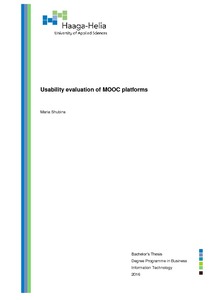Usability evaluation of MOOC platforms
Shubina, Maria (2016)
Shubina, Maria
Haaga-Helia ammattikorkeakoulu
2016
All rights reserved
Julkaisun pysyvä osoite on
https://urn.fi/URN:NBN:fi:amk-2016060111209
https://urn.fi/URN:NBN:fi:amk-2016060111209
Tiivistelmä
In recent years, the popularity of massive open online courses (MOOC) has increased significantly. MOOCs are one of the most promising and controversial trends in education for the last decade. Supporters tell that MOOC revolutionized traditional face-to-face learning process. Opponents think that this type of education has no future because completion rates are extremely low, and it hurts to high education standards. However, it is difficult to object that this type of open online courses opens new possibilities for distance learning and crushes geographical and time barriers.
The objective of this thesis paper is to evaluate overall user satisfaction of top three MOOC providers – Coursera, Udacity, and edX.
The framework of the thesis includes history and main milestones in the development of distance education, history of massive open online courses (MOOCs), MOOC structure, and different types of MOOC. Theoretical background also contains usability theory. The-sis research work includes questionnaire designing phase, results gathering process, and analysis of the research findings.
Findings of the research show levels of user satisfaction and its comparison among three MOOC platforms.
The objective of this thesis paper is to evaluate overall user satisfaction of top three MOOC providers – Coursera, Udacity, and edX.
The framework of the thesis includes history and main milestones in the development of distance education, history of massive open online courses (MOOCs), MOOC structure, and different types of MOOC. Theoretical background also contains usability theory. The-sis research work includes questionnaire designing phase, results gathering process, and analysis of the research findings.
Findings of the research show levels of user satisfaction and its comparison among three MOOC platforms.
